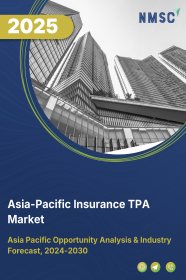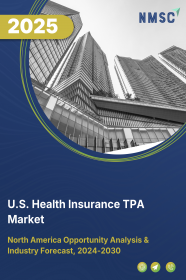
Asia-Pacific Insurance TPA Market by Type, (Health Insurance, Property and Casualty Insurance, Workers Compensation Insurance, Disability Insurance, Personal Accident Insurance, Travel Insurance, Cyber insurance and , Others), by Service, 9Claims Management, Risk Control Management), by End User (Healthcare, Construction, Real Estate and Hospitality, Transportation, Staffing, Banking, Travel and Tourism, Telecommunication, Other End User) – Opportunity Analysis and Industry Forecast, 2024 – 2030
Industry: BFSI | Publish Date: 09-Apr-2025 | No of Pages: 226 | No. of Tables: 156 | No. of Figures: 101 | Format: PDF | Report Code : BF2725
US Tariff Impact on Asia-Pacific Insurance TPA Market
Trump Tariffs Are Reshaping Global Business
Asia-Pacific Insurance TPA Market Overview
Asia-Pacific Insurance TPA Market size was valued at USD 87.51 billion in 2023, and is predicted to reach USD 172.43 billion by 2030, at a CAGR of 9.1% from 2024 to 2030.The insurance third-party administrator (TPA) market focuses on the provision of administrative services for insurance companies, including claims processing, customer support, and policy management.
TPAs act as intermediaries between insurers and policyholders, handling a range of tasks such as processing claims, managing customer inquiries, and ensuring compliance with regulatory requirements. The primary advantage of the insurance TPA is to streamline insurance operations, reduce operational costs, and enhance service efficiency for insurance companies.
By outsourcing administrative functions to specialized TPAs, insurers focus on their core business activities while benefiting from the expertise and technology that TPAs offer. As the insurance industry continues to evolve, driven by increasing customer expectations and regulatory changes, the insurance TPA market plays a crucial role in optimizing operational performance and improving overall customer experience.
Rising Motor Vehicle Purchases Fuel Asia-Pacific Insurance TPA Market Growth
The Asia-Pacific insurance TPA market growth is owing to the number of motor vehicle purchases in this region that increase the demand for motor insurance policies in this region. The motor insurance policy provides financial coverage to the vehicle of owners, owing to the loss caused by theft or accident.
According to a report published by Our World in Data, China’s car sales grew from around 20.34 million units in 2022 to 21.32 million units in 2023, marking an increase of about 5%. Thus, this rise in motor insurance policies by insurance companies tends to outsource their claim settlement services to insurance TPA, that boosts the insurance TPA market in this region.
Impact of Natural Disasters Drives the Insurance TPA Market Expansion in Asia-Pacific
The rising instance of various catastrophic natural disasters such as floods, earthquakes, and storms, cause huge damage to the properties of individuals in this region. This enables people to purchase property insurance plans to cover financial losses caused due to unforeseeable circumstances. This, in turn, leads to a rise in the number of insurance policies and propels the market growth for insurance TPAs with the surge in outsourcing services to handle various policy claims.
Regulatory Complexities Restricting the Expansion of Asia-Pacific Insurance TPA Market
Inconsistent regulations across the region pose operational challenges for Third Party Administrators (TPAs), making it difficult to maintain uniform standards, ensure compliance, and build trust among insurance providers and customers. These regulatory disparities hinder the expansion and adoption of TPA services by creating uncertainty and complicating efforts to deliver consistent and reliable services across different markets.
The Advancements in Technologies Creates Future Growth Opportunities in the Market
Insurance companies reach more individuals and guarantee data-backed underwriting by utilizing technology. Technological advancements such as wearable technologies, blockchain, and artificial intelligence (AI) are further expected to boost the Asia-Pacific insurance TPA market expansion. Wearable technologies such as fitness bands and other gadgets provide insurers access to real-time health information on policyholders. This enables policyholders to track and monitor a person's physical and health-related activities. The provision of customized insurance products is aided by wearable technology.
China Holds the Dominant Market Share in Asia-Pacific Region
The insurance market in China is growing, owing to the growth in the aging population. This contributes to increasing health insurance policies as old aged people are more prone to diseases, and health insurance cover medical expenses and treatment of critical illnesses.
In addition, the population of China is aware of health risks after COVID-19, and rising healthcare costs provide ample growth opportunities for insurance companies in China. This, in turn, is expected to boost the insurance TPA market that offers claims processing and settlements efficiently.
Additionally, an increase in the sales of electric and hybrid vehicles, owing to various government initiatives to promote increased purchases of electric vehicles (EVs), is further expected to boost the motor insurance segment. For instance, in September 2022, the Government of China announced to extend the exemption of tax levied on electric vehicle purchases to the end of 2023. The tax exemption aimed to bolster the use of battery-powered cars on mainland Chinese roads.
This contributes to the increasing number of insurance policies, owing to the rise in the purchase of EVs. This is further expected to boost the insurance TPA market in China.
Singapore to Witness Substantial Growth in the Asia-Pacific Insurance TPA Market
The insurance industry in Singapore is growing, owing to various ongoing infrastructural projects, such as Resorts World Sentosa Expansion, Shaw Office Tower Redevelopment, and West Hill, Bukit Batok in Singapore. The construction of infrastructures requires different types of insurance policies, such as property insurance, workers’ compensation insurance, and commercial auto insurance, to protect various types of risk.
This contributes to the growing number of insurance policies that allow individuals to enable the development of construction projects in Singapore. Thus, the rise in the number of insurance policies drives the Asia-Pacific insurance TPA market demand, facilitating quick settlement of claims in this country.
Additionally, the growth in government initiatives to boost the purchase of electric vehicles leads to a rise in the number of motor insurance in the country. For instance, in April 2022, the Government of Singapore aimed to develop a greener future and encouraged an electrified vehicle population that contributes to achieving their vision for 100% cleaner energy vehicles by 2040.
The government also launched a new campaign with the ‘Power Every Move’ tagline to raise awareness of electric vehicles. This leads to rise in the adoption of electric vehicles among the population and a notable increase in the overall number of motor insurance policies in the country. This, in turn, is further expected to accelerate the insurance TPA market in Singapore.
Competitive Landscape
The promising key players operating in the Asia-Pacific insurance TPA industry includes Alankit Healthcare TPA Limited, MSH China, Sedgwick, Genins India TPA Limited, Good Health TPA Services Ltd., Safeway TPA Services Pvt. Ltd., Vidal Health TPA Pvt. Ltd., Crawford & Company, Gallagher Bassett Services Pty Ltd, Genpact Ltd., Heritage Health Insurance Tpa Pvt. Ltd., AKNA Health Insurance TPA Private Limited, Medi Assist Insurance TPA Private Limited, Ericson Insurance TPA Private Limited, Charles Taylor and others.
Asia-Pacific Insurance TPA Market Key Segments
By Type
-
Health Insurance
-
Disease Insurance
-
Medical Insurance
-
Senior Citizens
-
Adults
-
Minors
-
-
-
Property and Casualty Insurance
-
Homeowners Insurance
-
Car Insurance
-
-
Workers' Compensation Insurance
-
Disability Insurance
-
Personal Accident Insurance
-
Death and Permanent Disability
-
Medical Expenses
-
-
Travel Insurance
-
Medical Coverage
-
Trip Cancellation Coverage
-
Baggage and Personal Belongings Coverage
-
Accidental Death and Dismemberment (AD&D) Coverage
-
-
Cyber insurance
-
Gadgets and Personal Belongings Insurance
-
Mobile Phone
-
Laptop
-
-
Others
By Services
-
Claims Management
-
Risk Control Management
By End-User
-
Healthcare
-
Construction
-
Real Estate and Hospitality
-
Transportation
-
Staffing
-
Banking
-
Travel and Tourism
-
Telecommunication
-
Other End User
By Countries
-
Australia
-
China
-
India
-
Indonesia
-
Japan
-
Singapore
-
South Korea
-
Taiwan
-
Thailand
-
Rest of Asia-Pacific
Key Players
-
Alankit Healthcare TPA Limited
-
MSH China
-
Sedgwick
-
Genins India TPA Limited
-
Good Health TPA Services Ltd.
-
Safeway TPA Services Pvt. Ltd.
-
Vidal Health TPA Pvt. Ltd.
-
Crawford & Company
-
Gallagher Bassett Services Pty Ltd
-
Genpact Ltd.
-
Heritage Health Insurance Tpa Pvt. Ltd.
-
AKNA Health Insurance TPA Private Limited
-
Medi Assist Insurance TPA Private Limited
-
Ericson Insurance TPA Private Limited
-
Charles Taylor
REPORT SCOPE AND SEGMENTATION:
|
Parameters |
Details |
|
Market Size Value in 2023 |
USD 87.51 Billion |
|
Revenue Forecast in 2030 |
USD 172.43 Billion |
|
Value Growth Rate |
CAGR of 9.1% from 2024 to 2030 |
|
Analysis Period |
2023–2030 |
|
Base Year Considered |
2023 |
|
Forecast Period |
2024–2030 |
|
Market Size Estimation |
Billion (USD) |
|
Growth Factors |
|
|
Companies Profiled |
15 |
|
Countries Covered |
9 |
|
Customization Scope |
Free customization (equivalent up to 80 working hours of analysts) after purchase. Addition or alteration to country, regional, and segment scope. |
|
Pricing and Purchase Options |
Avail customized purchase options to meet your exact research needs. |

















 Speak to Our Analyst
Speak to Our Analyst





















